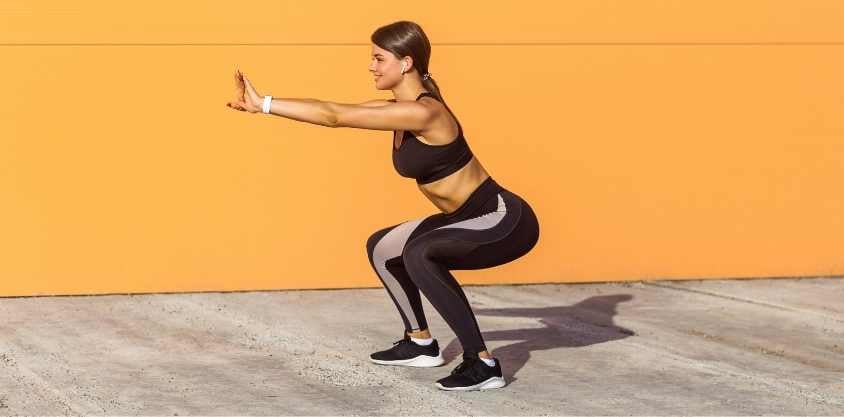Ready to transform your fitness with just one simple exercise? Discover how 50 squats daily can revolutionize your strength, shape, and well-being—no equipment required.
Can Just 50 Squats Daily Really Change Your Body?
If you’re searching for a straightforward yet powerful way to boost your fitness without complicated equipment or expensive gym memberships, the 50 squats a day challenge might be exactly what you need. This increasingly popular fitness approach has gained traction for good reason—it delivers remarkable results with minimal time investment.
But does this challenge actually work? What changes can you realistically expect? And how can you maximize your results? Let’s explore everything you need to know about this transformative daily practice.
The Science Behind Squats: Why They’re a Fitness Powerhouse
Squats are often called the “king of exercises,” and the science supports this royal title. This fundamental movement pattern engages multiple major muscle groups simultaneously, creating a comprehensive lower body workout that few other exercises can match.
The Anatomy of a Perfect Squat
When performed correctly, squats primarily target:
- Quadriceps: The large muscles at the front of your thighs
- Hamstrings: The muscles running along the back of your thighs
- Glutes: Your buttock muscles, particularly the gluteus maximus
- Core muscles: Including your abdominals and lower back
- Calves: Supporting muscles during the movement
- Hip flexors and adductors: Important stabilizing muscles
This multi-muscle engagement explains why squats deliver such comprehensive benefits. Unlike isolated exercises that target single muscle groups, squats create a functional, compound movement that mirrors activities we perform in daily life.
The Remarkable Benefits of the 50 Squats a Day Challenge
Physical Transformations
1. Sculpted Lower Body After just 2-3 weeks of consistent daily squats, many participants report noticeable changes in muscle tone, particularly in the quadriceps and glutes. While individual results vary based on factors like diet, rest, and existing fitness levels, the strengthening effect on lower body muscles is universal.
2. Enhanced Core Strength Proper squat form requires significant core engagement to maintain stability. Over time, this daily core activation leads to improved abdominal tone and better posture—benefits that extend far beyond the obvious leg muscle development.
3. Accelerated Metabolism Research suggests that exercises engaging large muscle groups, like squats, create a greater post-exercise oxygen consumption effect. This means your body continues burning calories at an elevated rate even after you’ve completed your squats, supporting weight management goals.
4. Improved Mobility and Flexibility Regular squatting improves range of motion in your ankles, knees, and hips. This enhanced mobility carries over to everyday movements like walking, climbing stairs, and bending—making daily activities easier and reducing injury risk as you age.
Beyond the Physical: Mental and Lifestyle Benefits
1. Boosted Confidence Accomplishing your daily squat goal creates a positive feedback loop of achievement. The visible progress and increased strength directly translate to improved self-confidence both in and outside the gym.
2. Enhanced Discipline Committing to any daily practice develops mental discipline. The 50 squats challenge provides a straightforward, achievable goal that strengthens your “consistency muscle”—a skill that benefits every area of life.
3. Increased Energy Levels Many challenge participants report improved energy throughout the day. This partly stems from improved circulation and the release of mood-enhancing endorphins during exercise.
Real Results: What to Expect Week by Week
Week 1: Adaptation Phase
- Initial muscle soreness (particularly days 2-3)
- Learning proper form becomes priority
- Potential need to break 50 squats into smaller sets
- Mental adjustment to the new daily routine
Week 2: Early Progress
- Significantly reduced muscle soreness
- Improved form and execution
- Ability to complete more squats in single sets
- Early signs of increased leg strength
Week 3: Noticeable Changes
- Visual changes may begin appearing in muscle tone
- Improved endurance during the squat routine
- Enhanced performance in other physical activities
- Established habit formation
Week 4 and Beyond: Transformation
- Clearly defined muscle development in thighs and glutes
- Improved posture from stronger core muscles
- Better overall lower body strength and stability
- Potential improvements in athletic performance
Maximizing Your Results: Expert Tips for Success
Perfect Your Form
Proper squat technique is essential for both safety and results:
- Start position: Stand with feet shoulder-width apart or slightly wider
- Initiate movement: Push your hips back as if sitting in a chair
- Knee alignment: Keep knees tracking over toes (not collapsing inward)
- Depth: Lower until thighs are parallel to ground (or as deep as comfortable with good form)
- Chest position: Keep chest upright throughout the movement
- Core engagement: Maintain a braced core for spinal protection
- Weight distribution: Keep weight in heels and midfoot (not toes)
Progressive Variations to Avoid Plateaus
As your body adapts to the challenge, consider these variations to continue making progress:
- Tempo squats: Slow down the descent to 3-4 seconds
- Pulse squats: Add small pulses at the bottom of the movement
- Split squats: Work each leg individually for greater challenge
- Weighted options: Hold light dumbbells or kettlebells when ready
Common Mistakes to Avoid
- Rushing through repetitions: Focus on quality over speed
- Neglecting proper warm-up: Always prepare your joints with dynamic stretches
- Ignoring rest days: If experiencing joint pain (not muscle soreness), take a day off
- Inconsistent depth: Maintain the same squat depth for all repetitions
- Inadequate hydration: Proper water intake supports muscle recovery
Creating a Sustainable Plan: How to Make the Challenge Work for You
For Beginners
If 50 squats seems overwhelming:
- Start with 20-25 squats daily, adding 5 squats each week
- Break your daily goal into multiple sets (e.g., 5 sets of 10)
- Consider starting with assisted squats using a chair or wall for support
For Intermediate Fitness Levels
To maximize your challenge:
- Complete all 50 squats in as few sets as possible
- Add squat variations to target muscles differently
- Incorporate other complementary exercises (planks, lunges, etc.)
For Advanced Fitness Enthusiasts
To continue seeing progress:
- Increase daily count to 75-100 squats
- Add resistance with weights or resistance bands
- Incorporate more challenging variations like jump squats or single-leg squats
Nutrition Support: Fueling Your Squat Challenge
Optimize your results with these nutritional strategies:
- Adequate protein intake: Supports muscle repair and growth (aim for 0.7-1g per pound of bodyweight)
- Hydration: Critical for muscle function and recovery
- Post-exercise nutrition: Consider a protein-carbohydrate snack within 30 minutes after your squats
- Anti-inflammatory foods: Incorporate foods rich in omega-3s and antioxidants to support recovery
Beyond the Challenge: Maintaining Your Results
Once you complete 30 days, consider these strategies to maintain and build upon your results:
- Continue with maintenance: Reduce to 2-3 sessions of 50 squats weekly
- Incorporate into a broader program: Use squats as one component of a more comprehensive fitness routine
- Set new challenges: Consider a squat depth challenge or weighted squat progression
Success Stories: Transformations from Real People
“I started the 50 squats challenge as a complete beginner. The first week was tough—I had to break it into 5 sets of 10 with rest breaks. By week four, I could do all 50 in two sets and noticed my jeans fitting differently around my thighs and butt. Beyond the physical changes, I’m proudest of proving to myself I could stick with something consistently.” – Madison, 34
“As someone who sits at a desk all day, the 50 squats challenge improved my posture significantly. I set a reminder to do 25 squats before lunch and 25 before dinner. After six weeks, my chronic lower back pain diminished, and I felt more energetic throughout the workday.” – Carlos, 42
Your Challenge Starts Now: Taking the First Step
The beauty of the 50 squats challenge lies in its simplicity and accessibility. You need no equipment, minimal space, and just a few minutes daily to transform your body and mind.
Remember that consistency trumps perfection. Even if you can’t perform all 50 squats with perfect form initially, showing up daily and giving your best effort will lead to remarkable improvements over time.
Are you ready to commit to stronger legs, improved fitness, and the satisfaction of daily achievement? Your 50 squats challenge begins with your very next squat.
Have you tried a squat challenge before? What results did you experience? Share your journey in the comments below!
This article is for informational purposes only. Consult with a healthcare professional before beginning any new exercise program, especially if you have existing health conditions or injuries.




